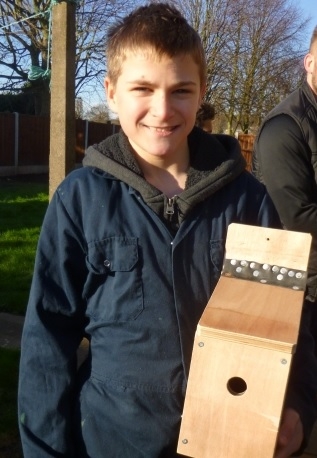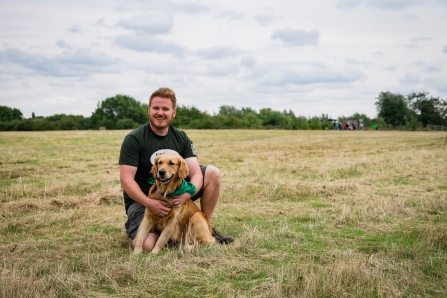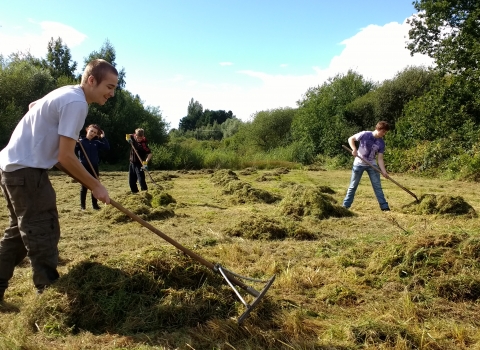The National Lottery Heritage Fund
What is the National Lottery?
The National Lottery – and with it National Lottery funding for good causes like heritage, arts, sport and charities – was established in 1994. Every ticket sold contributes funds to good causes across the UK.
National Lottery funding through the National Lottery Heritage Fund is one of The Wildlife Trusts most important sources of income and has helped us to achieve many amazing things for people and wildlife over the years.
About the National Lottery Heritage Fund
The National Lottery Heritage Fund is the largest dedicated funder of heritage in the UK.
Since its creation in 1994, The Wildlife Trusts have worked closely with the National Lottery Heritage Fund to connect people to nature and each other, save precious wildlife-rich places, create new woodlands, wetlands, meadows and many other habitats and protect rare and endangered species.
The National Lottery Heritage Fund has invested a total of £7.1bn in 40,000 heritage projects. The hundreds of Wildlife Trust projects across the UK supported by the National Lottery Heritage Fund have benefited thousands of people from all walks of life – helping them to experience the joy of wildlife in their daily lives; from children and young people to older generations; from those living in urban areas to those in the countryside, or by the coast.
Players of the National Lottery are helping Wildlife Trusts throughout the UK give a new lease of life to wildlife and wild places, and ignite the passions of individuals and communities to care for the wildlife on their doorstep.The Wildlife Trusts
How the National Lottery has helped Wildlife Trusts transform places and lives
Since 1994, National Lottery players have helped every eligible Wildlife Trust (that’s 44, by the way!) right across the UK deliver over 600 projects using money awarded by the National Lottery Heritage Fund. This has helped Wildlife Trusts to work alongside volunteers and other members of the local community to transform areas ranging from city roadside verges to vast areas of land and coast. Involving local communities does not just benefit wildlife – it also helps people to reconnect with local wild places, people experience improved health and wellbeing and it helps them to help themselves and others by learning new life skills or about subjects that can help society as a whole.
Here is just a few examples in Nottinghamshire of projects that was supported by the National Lottery Heritage Fund
Bringing People Closer to Nature
Our supported projects.
Thanks to the National Lottery Heritage Fund we have been able to carry out these fantastic projects.
April 2009 - Restoring the Idle Valley
The project aimed to demonstrate that conservation management and the enhancement of biodiversity could be central to economic and social regeneration. The project was based around 316 hectares of land which form the Sutton and Lound Gravel Pits Site of Special Scientific Interest (SSSI). Nottinghamshire Wildlife Trust is committed to securing both the SSSI and a further 140 hectares of surrounding land in perpetuity in order to create one of the most significant areas of natural heritage in the East Midlands.
The main aims were to
- Restore natural heritage and improve biodiversity.
- Improve public access for all.
- Improve visitor information and interpretation making it accessible to a wide audience
- In partnership with North Nottinghamshire College, deliver a programme of practical skills training courses that support the rural economy and rural way of life.
- Develop a programme of community engagement.
- Develop a programme of environmental education
- Work with surrounding local landowners to improve Green Infrastructure and build a protective buffer around the project area.
Outcomes
- Significant habitat works had taken place, with 9 islands and approximately 6 hectares of land being cleared of scrub.
- Sheep were introduced on a large island on Neatholme Scrape to help keep on top of willow re-growth.
- Increased numbers of bird species such as oyster catcher, lapwing, Little ringed Plover and avocet were noted.
- 2684m of stock fencing has been erected across parts of the site, providing an additional 17.65 hectares.
- 5.9km of hedgerows have been created, restored or maintained.
- 431 Volunteers attended work party days.
- A new viewing platform was created.
- 6 benches have been installed,
- New access was provided off Cross Lane so that visitors and works traffic are no longer mixed, providing a better surface for walkers.
- A number of conservation themed sessions took place including a Bird walk and Willow Weaving
Agnes Kiemel shares her memories and the impact of the project:
"Because of lottery funding, our flying flock of conservation grazing sheep has gone from strength to strength. Building a lambing shed has given over 350 rare breed Hebridean and Herdwick sheep the best start to life.
With help from our volunteers (and sheepdogs Dom and Lyn) I keep the flock moving round our nature reserves. Their grazing keeps grass under control, ensuring vital species flourish, keeping our reserves havens for wildlife.
As well as boosting biodiversity, our flock helps build people’s connections the Wildlife Trust. We often get chatting to visitors of all ages, interested in and engaged by the sheep, keen to find out just what we are doing and how they might help our wider work. Children are especially drawn to our wooly workers!
The lambing year is nearly ready to start again. Soon a new crop of lambs will be on their way. Fresh straw and cosy pens at the ready, thanks to our lottery funded shed. " October 2019
November 2011 - Attenborough's ACE: Access-Community-Education
In 2011 Nottinghamshire Wildlife Trust developed a project titled Attenborough’s Access, Community, Education (ACE) for which Heritage Lottery Funding was granted.
The project was built on previous research conducted in 2008 & 2009, input from staff and historical experience of the centre and aimed to:
- Improve visitor experience and facilities
- Improve education and participation opportunities for visitors
- Improve accessibility to the reserve and its information
- Improve physical habitats for wildlife.
This short film highlights the project and its outcomes.
February 2012 - Sherwood’s Historic Heathlands
Sherwood’s Historic Heathland was an inspiring education and practical conservation project led by Nottinghamshire Wildlife Trust, which took place between Autumn 2011 and Winter 2013. It focused on Strawberry Hill Heath (a remnant of the iconic Sherwood Forest). This project delivered habitat improvement across 7 hectares of Strawberry Hill Heath, plus an intensive programme of community activity and education work that strived to embed a sense of the habitats heritage and rarity value amongst the communities of Ashfield and Mansfield. This project also provided opportunities for volunteer involvement in education delivery and practical conservation tasks at Strawberry Hill Heath as well as helping to protect nesting sites suitable for Nightjars.
Outcomes
- 100% Complete - we have cleared trees from 10ha of Strawberry Hill Heath, creating open areas which are now reverting to heathland.
- Two fenced areas have been created, specifically to provide safe nesting areas for nightjar.
- The project has delivered 61 heathland based sessions to ten primary and secondary schools and seven community groups
- A total of 423 hours were volunteered by 20 people, including two skilled volunteers and 18 unskilled volunteers. These volunteer hours were used to deliver education sessions with schools, community groups and at community events.
- A total of 1213 hours were volunteered over 26 practical sessions, delivering a large amount of work on the nature reserve.
- The work experience programme delivered twenty sessions focussed on heathland habitats and their heritage
- The message of rarity and value of local heathland habitats was communicated to 1983 young people throughdelivery to schools, community groups and at community events.
Berry Hill, Rainworth
Reptile survey
Vicar Water event
Vicar Water event
Invertebrate survey
June 2013 - Growing Treswell: Restoring our Ancient Woodlands
The aim was to purchase 10 acres of farmland, so a missing piece of the ancient woodland could be restored, allowing it to be brought into long term wildlife-friendly management.
This project also allowed for the development of a series of engaging and interesting interpretation materials about the heritage of Treswell Wood as well as creating a programme of ancient woodland-focused educational activities, including school sessions, holiday clubs and a variety of courses in traditional heritage crafts. HLF funding along with a popular public appeal helped to make this project a success.
Outcomes
- 12 sessions at Treswell Wood were delivered in total. Six of these were informal education sessions for families during the school holidays. The remaining 6 sessions were visits from local primary schools.
- In total 132 children and 39 adults attended the sessions.
- The content of the sessions focussed on the wildlife and heritage of this special site. We also examined the plants of the wood management practices including coppicing and how felling selected trees allows sunlight to penetrate the woodland floor and the plants to grow.
- Many of the sessions used the “green workshop” area in the woods which is a space used by traditional woodland craftspeople which inspired discussions about the heritage of these activities.
Treswell wood acquisition launch party
New Treswell interpretation boards
Treswell wood acquisition launch party
Treswell green workshop
Treswell wood
Whilst celebrating the National Lottery's 25th Anniversary during 2019, Chris from Treswell Wood Integrated Population Monitoring Group said
“A group of volunteers, the Treswell Wood IPM Group, has been active in the wood since its purchase by the Trust in 1972. Work is aimed primarily at bird monitoring with ringing, nest recording and breeding territory mapping. However, habitat, on which birds depend, is also recorded in addition to more casual records of non-bird species. With the coppice management, changes in habitat are considerable and can be very rapid. The long-term systematic data set has allowed (amongst other things) analysis of the relationships between coppicing and bird populations and resulted in paper in a major ornithological journal.”
The Treswell Wood IPM Group has seen a succession of students over the years allowing them to gain experience in real survey work, giving them material for dissertations and, in some cases, launching them into successful ornithological careers.
Chris continued “Perhaps the most exciting recent development is that of the assart. With Lincoln University we began a long-term study of its natural return to woodland. Several students have already been involved in the survey work and it is hoped to publish some results after the 2020 survey of tree growth. The assart provides an opportunity for a unique study - natural woodland regeneration coupled with the detailed long-term dataset from the surrounding mature woodland. The study has been further enhanced by the arrival of ash dieback disease which appears to be suppressing almost all ash regeneration. Paradoxically, the disease will allow development of a more diverse woodland than the ash almost-monoculture that would have otherwise taken over. Exciting times for the ecologists and conservationists because of the funding from HLF.”
April 2014 – Young Roots
Nottingham Wildlife Trust developed a Wildlife in the City project, to create better opportunities for young people to take a leading role in their natural heritage.
With the aim to
- Provide regular volunteering opportunities for young people
- For young people to learn new skills to enable them to participate in the management of their local parks and nature reserves.
- Create a core group of volunteers which will be made up of young people from the local communities as well as youth offenders
- For young people to learn these new skills, gain confidence and be encouraged to pursue a career in conservation.
Outcomes
- Over 17 Natural Heritage sites worked on throughout the city
- 110 individuals have gained skills in practical conservation and the importance of local natural heritage.
- 14 Young people aged 13-25 attended a Youth Steering group 2 day workshop
- 4 Community events attended by project officer engaging with 590 people
- 2 events devised and ran by the Youth steering group engaging with 470 people
- 264 days of volunteer time has taken place over the 2 years of the project
- 8 young people, 6 trustees and 3 staff members attend NWT first ever Youth Consultation day
- 7 volunteers received accredited training
- The legacy of receiving two different forms of funding to continue elements of the projects work
Habitat management
Dead hedging

Nest box building
Youth Worker, Jamie Shortland reminisces fondly about his time working on the project:
“Because of Lottery funding we have been able to target more hard to reach young people through our Young Roots program. I worked with young people from behavioural units and young offenders to not only get them out into their local greenspaces but to give them skills for the future.
With help from our therapy dog Luna, I was able to take a small group of young people to teach them wildlife gardening and how to grow their own vegetables by creating an allotment in the school grounds, we even used some of the vegetables grown to cook a Christmas dinner as a group. This social interaction as well as learning to use tools and cook healthy meals for themselves gave these young people skills they can and have continued to use after the program finished, some even volunteered on other conservation projects around the county with us!
One of my favourite memories from Young Roots was during a day trip to Attenborough Nature Reserve, the young people were learning about invasive species and removing Himalayan Balsam when a grey heron popped out of a nearby reed bed –the look of amazement on their faces as none of them had seen a heron before was incredible.
Young Roots also created the first youth steering group for Nottinghamshire Wildlife Trust and the youth program continues to evolve and gets better each year – none of which would have been possible without Lottery funding!”

Youth Worker, Jamie Shortland with his therapy dog Luna. Credit Phil Lockwood.
Jamie Shortland with Luna his therapy dog.
Autumn 2014 - Spring 2018 Not a Blott on the Landscape (Skylarks)
2014/2015 Nottinghamshire Wildlife Trust successfully raised funds to purchase land adjacent to our Skylarks site to create Rushcliffe's largest nature reserve. This was achieved with help from the National Lottery Heritage Fund and with the support of our members and donors. This project also allowed Nottinghamshire Wildlife Trust to invest significantly in habitat and access improvements and engagement programmes set to work to reach out to people and inspire them to visit, participate and learn.
Outcomes
- The land was successfully purchased, creating the largest nature reserve in Rushcliffe.
- Accessible features were created, including a board-walk and sensory hide.
- A number of outreach sessions were carried out including, public and school learning.
- Young Rangers (youth volunteering) is regular and has now become a strategic priority for NWT
© Susie Rees
Expanding Skylarks Nature Reserve thanks to the Heritage Lottery Fund
© Susie Rees
Skylarks excavations
© Susie Rees
Blotts pit
Skylarks through the seasons 2015-2017 - a film by INSTAR (https://youtu.be/gaPrQtQDis8)
A film documenting Skylarks Nature Reserve through the seasons 2015-2017. Created by INSTAR
National Lottery 25th Anniversary update:
Skylarks now supports many species including Ragged-Robin in the wet grassland and breeding birds such as Little Ringer Plover, Oystercatcher and over a thousand Lapwing on site, it is also used as a refuelling site for migrant birds in the Trent Basin such as Sanderling, Turnstone and Black Tailed Godwit.
Work across the site by staff and a dedicated group of volunteers has improved the habitat vastly, flora has evolved, birds, bats and invertebrates are thriving and the areas of open water have so improved quality that otters are now regularly recorded on site.
During August 2019 on site Nottinghamshire Wildlife Trust held its first ‘Wilder Woodland Gathering’ which saw over 500 attendees come to the reserve to engage with and learn about the wildlife on their doorstep. Without the help of lottery funding this haven for wildlife and the local community would not be as it is today.
2018-2022 - Working for Nature
The Working For Nature trainee scheme is an exciting project generously funded by the National Heritage Lottery which enabled 6 lucky trainees the chance to work alongside The Wildlife Trusts for a year to develop professional skills for a career in conservation.
Six placements are awarded each year and the project runs for 4 years from 2018 – 2022. The recruits study for a Level 2 diploma in Environmental Conservation and work alongside professionals in the field learning valuable lifelong skills along the way. Thanks to the National lottery, successful applicants will receive a generous bursary of £10,875 to cover the year working with the trusts.
The project is split between 3 of our Trusts – Derbyshire Wildlife Trust, Nottinghamshire Wildlife Trust & Sheffield & Rotherham Wildlife Trust and 2 trainees will be selected from each area each year.
2019 Miner2Major
Miner2Major: the real Sherwood Forest is a five-year, Landscape Partnership Scheme, supported by the Heritage Lottery Fund. Whilst still in the infancy of the project, work has already started to reach communities in urban areas around the historic Sherwood Forest area in Nottinghamshire. To inspire them but to reconnect them to such a historically and culturally important place.
Nottinghamshire Wildlife Trust manages three nature reserves within the project area which support rare heathland ancient woodland habitats but will also be working with different landowners to restore and protect land, creating a network of wild areas for species such as the Common lizard, Nightjar and Woodlark.
Jamie Shortland, M2M Volunteer Wildlife Coordinator said “We are reaching out to the local communities across the Mansfield and Sherwood area, one of our first events is a wildlife walk on an RSPB reserve to connect local people to the greenspaces and wildlife local to them. It is great to be able to team up and work in partnership with other conservation charities on this project to not only inspire people now but to create a lasting legacy, that wouldn’t be possible without the heritage lottery fund supporting us.”
2022 Nextdoor Nature
Nextdoor Nature brings communities together to help nature flourish where they live and work. Thanks to £5 million funding from The National Lottery Heritage Fund, Nextdoor Nature will provide people with the advice and support they need to help nature on their doorstep, and leave a lasting natural legacy to mark the Queen’s Platinum Jubilee.
2023 Attenborough for All
Attenborough for All (A4A) is an 18-month pilot project supported by the National Lottery Heritage Fund. We have been developing our vision for this much-loved site and want to ensure it reflects a wide range of views.
We will listen to our visitors, run focus groups and carry out audits to define and understand our audience, why people visit, what they need, and how accessible the reserve is. We want to understand how visitors feel about different areas of the reserve and assess how important wildlife encounters are as part of their experience. We hope to inspire our visitors to take action for wildlife whilst supporting nature recovery and climate change resilience within the reserve.
Through community consultation, we will establish who from the adjacent communities isn’t visiting or benefiting from the reserve and test different engagement methods. We want to identify and remove physical, cultural or perceptual barriers to access and enjoyment of the reserve. We will create a meaningful, accessible, inspiring and inclusive experience.
Our project insights will provide the foundations for a future bid to aid the delivery of our vision for Attenborough Nature Reserve, ensuring it remains a protected, much-needed space for wildlife and people.
Information on other projects funded by the National Lottery Heritage Fund can be found on their website.


